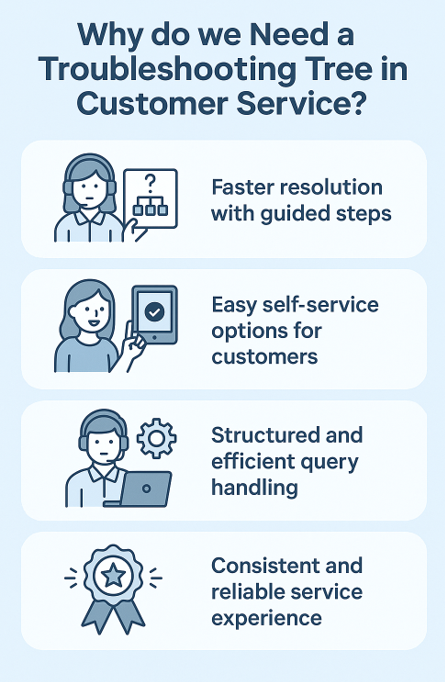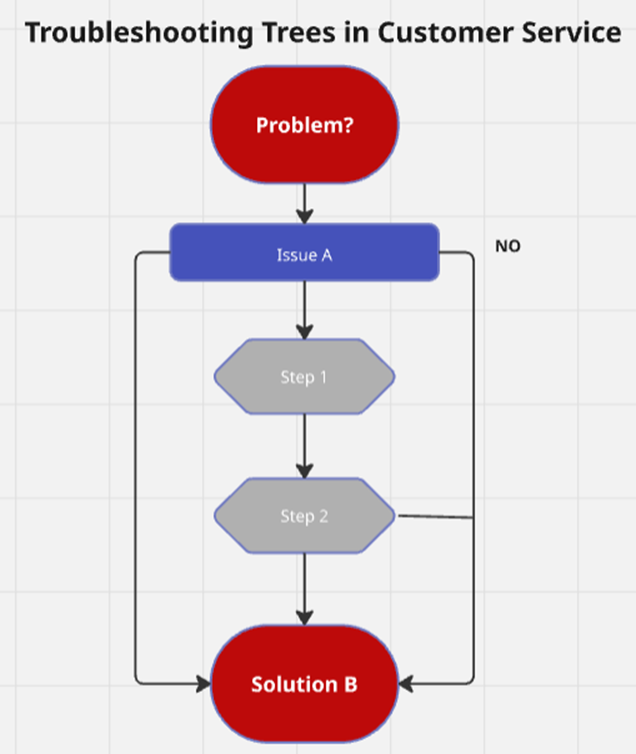In customer service, knowledge is power. The longer you spend on troubleshooting customer queries, the less time customers spend on using and enjoying your products, and they resent the time they spend having to contact customer service to resolve a problem they believe shouldn’t have happened in the first place.
The most highly skilled customer service teams utilize a type of documentation called a troubleshooting tree. Instead of reinventing the wheel every time, customer service reps can follow a particular process to troubleshoot a customer problem and find the right solution.
The use of the term tree is of particular importance: customer service teams can plant seeds that eventually grow into a powerful tree that can be used to avoid trial and error. It’s a formal system that your reps can follow to arrive at the correct answer in the fastest time possible.
What Is a Troubleshooting Tree?
A troubleshooting tree is a formal system that gets your support agents from point A to point B in a structured fashion. It provides the user with different options that they can use to troubleshoot a particular situation encountered by a customer, taking them through a logical flow that eventually arrives at the correct solution for the problem.
Troubleshooting trees can be complex or simple, but are visualized like the branches of a tree. Users can follow each step of the tree to gradually eliminate certain possibilities, representing common ways that the service rep might approach fixing problems that are dealt with by the troubleshooting tree.
They can be hosted on your AI knowledge base as an internal resource for your customer service reps. Unlike other types of documentation, a troubleshooting tree is a visual representation of the process of tackling customer issues.
Why Do We Need a Troubleshooting Tree in Customer Service?

- Faster resolution with guided steps – The advantage of a troubleshooting tree is that it less time searching for a solution to the customer’s issues. Service reps can simply use the troubleshooting tree to guide them through the process of identifying and solving the problem, leading to faster resolution and the ability to help more customers.
- Easy self-service options for customers – Customers can be provided with troubleshooting trees as a self–service option for handling their problems. If the issue can be solved easily by the customer with the troubleshooting tree, then fewer tickets are submitted to your support team.
- Structured and efficient query handling – No matter who is handling the customer’s problem, the process is structured and efficient because agents know exactly what steps to go through when presented with an issue. This provides a better environment for your agents to troubleshoot common problems.
- Consistent and reliable service experience – Troubleshooting trees adds an element of consistency to customer service, meaning that whichever rep picks up the customer ticket has ready-made documentation to help them solve the problem. Customer service teams are achieving reliable service by documenting the exact steps it takes to resolve the issue.
- Higher customer satisfaction and loyalty – When you solve every problem quickly with the minimum of fuss, you can attain higher customer satisfaction and loyalty, with customers who know they can rely on your service team to quickly and efficiently solve their issues.
How to Build an Effective Troubleshooting Tree?
Analyze Common Customer Issues and Queries
The first step in building a troubleshooting tree lies in identifying common customer issues. By finding out which are the most frequent queries from your customers, you will begin to see a pattern that can be more easily documented. In troubleshooting trees, several issues can be connected but require very different solutions, and they will be represented by different branches on the tree.
Define Clear Steps and Decision Points
When you know which issues you want to document, you must chart the flow of your troubleshooting tree by defining clear steps and decision points. A simple representation of these steps would be “If A, then do this,” and “If B, then do this”. These are the steps and decisions that will guide your customer service reps through the troubleshooting tree and help them solve the problem.

Keep It Simple and Intuitive
Troubleshooting trees should be kept as simple as possible: limit it to the minimum number of steps necessary to arrive at a solution. If your tree is getting too complex, then you might want to think about breaking it into two or more trees. Keep your descriptions as simple and obvious as you can – any agent must be able to pick up your troubleshooting tree and use it to solve a problem.
Use Visual Tools for Better User Experience
Use software like Document360 to better document your troubleshooting trees, designed to accommodate visual documents that are harder to produce than text alone. When you choose the right software, you can make beautifully engaging troubleshooting trees that visually hook the user and can be easily used to solve problems.
Test and Refine the Tree with Real Scenarios
When you’ve made your troubleshooting tree, test it out with real-world scenarios and make adjustments if needed. You may find that you encounter unexpected outcomes that must be accounted for in the troubleshooting tree. Your tree might be overly simplistic and need expansion to account for the full breadth of the issues that customers face.
Regularly Update the Troubleshooting Tree
Once you’ve launched your troubleshooting trees, review and revise them. Customer service changes constantly, and you might have new issues that could be effectively documented with a troubleshooting tree. When you identify a new issue, go through this process again.
Examples of Troubleshooting Trees
- Managing Technical FAQs Through Interactive Trees – Technical FAQs are especially suited to interactive troubleshooting trees because they are usually concrete steps that the agent can go through when diagnosing the problem.
- Setting Up Product Setup Guides for New Users – New products can be tricky for your users, and providing them with product setup guides can significantly cut the time it takes for adoption.
- Building a Decision Tree for Account Management Queries – Nurturing customers is a lot easier when you use a decision tree or troubleshooting tree to guide them through the process of interacting with the business. For example, if the customer shows a high level of activity, do X.
- Creating a Troubleshooting Tree for Common Software Errors – Software is also a great industry for using troubleshooting trees because you can ask a user to perform an action, then analyze the result for the software in question.
- Designing a Billing and Subscription Support Tree – Taking customers through billing and subscription can be challenging, but a troubleshooting tree can guide you through the steps for this process.
Check out our video on creating an interactive decision tree that instantly guides users to the right content
The Takeaway: Why Troubleshooting Trees Are Essential
There are various variables when it comes to customer service, and much of the support quality and speed depends on which agents are picking up the issues. If you take the time to document troubleshooting trees that offer a formal structure, then you can make customer service much more effective.
Documenting your troubleshooting trees in knowledge base software like Document360 is vital for ensuring a successful support operation. You can take common troubleshooting processes and turn them into a step-by-step flow that ultimately arrives at the best solution for the issue.




 –
– 

